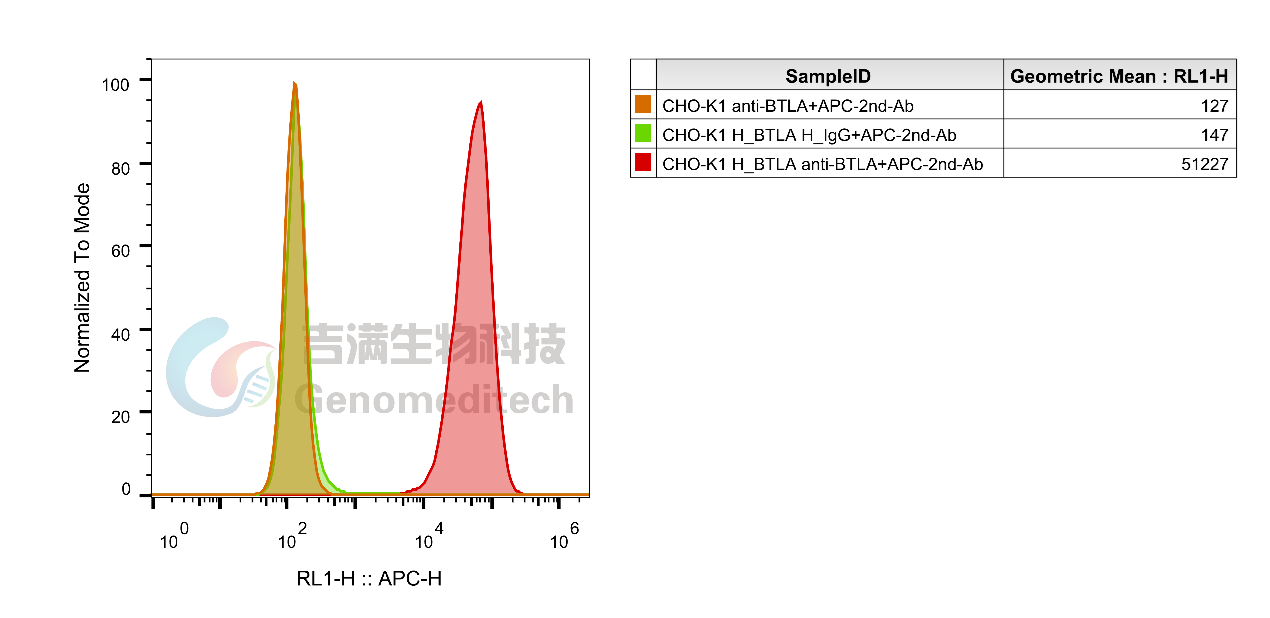Cat.No:GM-28675AB
Product:Anti-BTLA hIgG4 Antibody(Icatolimab)
Cat.No:GM-28675AB
Product:Anti-BTLA hIgG4 Antibody(Icatolimab)
GM-28675AB-10 10 μg
GM-28675AB-100 100 μg
GM-28675AB-1000 1mg
Species Reactivity Human
Clone Icatolimab
Source/Isotype Monoclonal human IgG4, κ
Application Flow Cytometry
Specificity Detects BTLA
Gene BTLA
Other Names BTLA1, CD272
Gene ID 151888
Background B- and T-lymphocyte attenuator or BTLA (also known as cluster of differentiation 272 or CD272) is a protein that belongs to the CD28 immunoglobulin superfamily (IgSF) which is encoded by the BTLA gene located on the 3rd human chromosome. BTLA is a 289 amino acid long transmembrane glycoprotein. It consists of an extracellular domain, a transmembrane domain, and a cytoplasmic domain, similar in structure to PD-1 and CTLA-4. HVEM is the main ligand of BTLA which has inhibition and activation capacities. When a T cell is fully activated HVEM is internalized, and this allows BTLA to interact in a trans manner (with molecules on other cells). This enables other cells who express HVEM to regulate activated T cells. Treg cells express HVEM and can facilitate immune suppression through interaction with BTLA. Furthermore, the blockage of BTLA together with PD-1 can help reverting the state of exhaustion
Storage Store at 2-8℃ short term (1-2 weeks).Store at ≤ -20℃ long term. Avoid repeated freeze-thaw.
Formulation Phosphate-buffered solution, pH 7.2.
Endotoxin < 1 EU/mg, determined by LAL gel clotting assay

Cat.No:GM-28675AB
Product:Anti-BTLA hIgG4 Antibody(Icatolimab)
GM-28675AB-10 10 μg
GM-28675AB-100 100 μg
GM-28675AB-1000 1mg
Species Reactivity Human
Clone Icatolimab
Source/Isotype Monoclonal human IgG4, κ
Application Flow Cytometry
Specificity Detects BTLA
Gene BTLA
Other Names BTLA1, CD272
Gene ID 151888
Background B- and T-lymphocyte attenuator or BTLA (also known as cluster of differentiation 272 or CD272) is a protein that belongs to the CD28 immunoglobulin superfamily (IgSF) which is encoded by the BTLA gene located on the 3rd human chromosome. BTLA is a 289 amino acid long transmembrane glycoprotein. It consists of an extracellular domain, a transmembrane domain, and a cytoplasmic domain, similar in structure to PD-1 and CTLA-4. HVEM is the main ligand of BTLA which has inhibition and activation capacities. When a T cell is fully activated HVEM is internalized, and this allows BTLA to interact in a trans manner (with molecules on other cells). This enables other cells who express HVEM to regulate activated T cells. Treg cells express HVEM and can facilitate immune suppression through interaction with BTLA. Furthermore, the blockage of BTLA together with PD-1 can help reverting the state of exhaustion
Storage Store at 2-8℃ short term (1-2 weeks).Store at ≤ -20℃ long term. Avoid repeated freeze-thaw.
Formulation Phosphate-buffered solution, pH 7.2.
Endotoxin < 1 EU/mg, determined by LAL gel clotting assay
